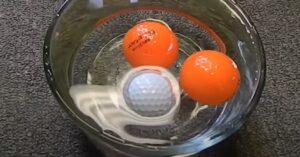how many dimples are on a golf ball? [Science behind Dimples]
Golf enthusiasts know that the dimples on a golf ball play a crucial role in its flight. But have you ever wondered just how many dimples are on a golf ball? The answer may surprise you.
The number of dimples on a golf ball can vary, but most golf balls have between 300 and 500 dimples.
In this blog post, we’ll take a closer look at the science behind the dimples on a golf ball and explore how they affect the ball’s performance on the course. So grab your driver, and let’s tee off!
How do dimples affect the aerodynamics of a golf ball?
Dimples on a golf ball affect its aerodynamics by creating turbulence in the air around the ball.
This turbulence, known as a boundary layer, causes the air pressure on the front of the ball to be higher than on the back, creating lift.
![how many dimples are on a golf ball? [Science behind Dimples] 1 How do dimples affect the aerodynamics of a golf ball?](http://giftedgolfers.com/wp-content/uploads/2023/01/image-54.png)
The dimples on the ball cause the boundary layer to transition from laminar (smooth) flow to turbulent flow earlier than it would on a smooth ball, which reduces the drag on the ball and allows it to travel farther.
Additionally, the dimples help to reduce the separation of the airflow on the ball’s surface, which also helps to reduce drag.
Overall, the dimples on a golf ball help to increase the lift and reduce the drag, allowing it to travel farther and more accurately through the air.
What is the significance of dimples on a golf ball?
Dimples on a golf ball significantly impact the ball’s flight and performance. They are considered a crucial design element in the aerodynamics of a golf ball.
![how many dimples are on a golf ball? [Science behind Dimples] 2 What is the significance of dimples on a golf ball?](http://giftedgolfers.com/wp-content/uploads/2023/01/image-52-1024x646.png)
Dimples reduce drag
The smooth surface of a golf ball creates a thin layer of air around it called the boundary layer.
Dimples disrupt the smoothness of the boundary layer, creating small, turbulent eddies of air that detach from the ball’s surface.
This turbulent flow reduces the skin friction drag, which allows the ball to travel farther through the air.
Dimples increase lift
The dimples on a golf ball also create a region of low pressure behind the ball, which generates lift.
This lift helps the ball to stay in the air for a longer period, which ultimately leads to longer shots.
Dimples can change the spin
The deeper the dimples; the more lift is produced and the less spin the ball will have.
On the other hand, shallow dimples will produce less lift and more spin. This can create different types of shots for different situations on the course.
Dimples can improve accuracy
Different dimple patterns can be used to create different shots and improve accuracy.
Golf balls with more dimples will tend to be more stable in the air and less affected by wind, while those with fewer dimples will be more responsive to spin and more affected by wind.
Overall, dimples are considered a crucial design element of a golf ball because they help reduce drag, increase lift and change the ball’s spin, leading to longer shots, better control of the ball in the air, and improved accuracy.
Why are dimples considered a crucial design element of a golf ball?
Dimples are considered a crucial design element of a golf ball because they greatly affect its aerodynamics in flight.
The dimples on a golf ball create turbulence in the air around the ball, which greatly reduces the air resistance or drag the ball encounters.
![how many dimples are on a golf ball? [Science behind Dimples] 3 Why are dimples considered a crucial design element of a golf ball?](http://giftedgolfers.com/wp-content/uploads/2023/01/image-53-1024x508.png)
A smooth ball without dimples would have a much higher drag coefficient, which would cause it to slow down much more quickly in flight.
Dimples on a golf ball create a thin layer of turbulent air around the ball that helps to “attach” the air to the ball, reducing the drag and allowing the ball to maintain its velocity for longer.
In addition to reducing drag, dimples also affect the golf ball’s lift. A golf ball with dimples will have a higher lift coefficient than a smooth ball, which means it will tend to stay in the air longer and fly farther.
Overall, dimples are a crucial design element of a golf ball because they allow it to maintain its velocity and travel farther, providing a golfer with more distance on their shots.
How do dimple patterns vary on different types of golf balls?
![how many dimples are on a golf ball? [Science behind Dimples] 4 How do dimple patterns vary on different types of golf balls?](http://giftedgolfers.com/wp-content/uploads/2023/01/image-57-1024x691.png)
Dimple patterns can vary significantly between different types of golf balls. The number and shape of dimples can affect the flight of the ball and the amount of lift and spin that is generated.
- Distance balls typically have fewer, larger dimples that cover a greater percentage of the ball’s surface. This helps to reduce drag and increase lift, allowing the ball to travel farther through the air.
- Tour or high-performance balls have smaller, shallower dimples that cover a smaller percentage of the ball’s surface. This creates more spin on the ball, allowing for more control and precision in the air.
- Control balls have a different dimple pattern. They have a higher number of dimples with various shapes and sizes. This gives the golfer more control over the ball’s trajectory and spin, particularly in windy conditions.
- Some golf balls have a combination of dimple patterns, known as multi-layer balls. This type of ball is designed to perform well in different types of shots and conditions.
It’s worth noting that manufacturers often patented dimple patterns which can differ from brand to brand and model to model. Manufacturers consider the dimple pattern a trade secret, and therefore, it’s not disclosed to the public.
Factors that affect the flight of a golf ball besides number and pattern of dimples
Yes, several other factors can affect the flight of a golf ball. Some of these include-
![how many dimples are on a golf ball? [Science behind Dimples] 5 Factors that affect the flight of a golf ball besides number and pattern of dimples](http://giftedgolfers.com/wp-content/uploads/2023/01/image-55.png)
Spin
The golf ball’s spin can affect its trajectory and landing. A ball with a backspin will stay in the air longer and land softer, while a ball with a topspin will tend to descend more steeply and bounce farther.
Speed
The speed at which a golf ball is hit can also affect its flight. A faster swing will result in a ball that travels farther, while a slower swing will result in a shorter shot.
The angle of attack
The angle at which a golf ball is hit can also affect its flight. A ball that is hit on a descending angle will tend to have more backspin.
When a ball that is hit on an ascending angle will tend to have less spin and a higher trajectory.
Clubface angle
The angle of the clubface at impact can also affect the golf ball’s flight. A clubface that is open (pointing to the right of the target for a right-handed golfer) will tend to produce a shot that curves to the right.
While a clubface that is closed (pointing to the left of the target) will tend to produce a shot that curves to the left.
Weather conditions
The weather conditions at the time of a round of golf can also affect the flight of a golf ball.
For example, wind can greatly affect the trajectory of a ball and make it more difficult to predict.
![how many dimples are on a golf ball? [Science behind Dimples] 6 dimples on golf ball](http://giftedgolfers.com/wp-content/uploads/2023/01/image-56.png)
FAQs
Here, we aim to answer some of the most commonly asked questions about the role of dimples on a golf ball, their number, shape, and depth, and how they affect the ball’s performance on the course. So, let’s dive in and explore the world of dimples on golf balls!
Why do golf balls have dimples?
Dimples on a golf ball create turbulence in the air around the ball, which reduces drag and helps the ball fly further.
Can dimples affect the spin of a golf ball?
Yes, the shape and depth of the dimples can affect the spin of a golf ball. For example, a ball with deeper dimples will have less backspin, and a ball with shallower dimples will have more backspin.
Can I add dimples to my golf ball?
Adding dimples to a golf ball is not recommended, as it can alter its performance and void the warranty. It’s better to buy a ball that meets your needs.
Do all golf balls have the same number of dimples?
No, not all golf balls have the same number of dimples. Some golf balls may have more or fewer dimples depending on the manufacturer and the type of ball.
Is it true that the dimples on a golf ball are there to mimic the feathers on a shuttlecock?
Yes, a golf ball’s dimples were designed to mimic the feathers on a shuttlecock. The dimples create turbulence in the air, similar to the feathers on a shuttlecock, which helps the ball fly further.
How deep should dimples on a golf ball be?
The depth of dimples on a golf ball can vary, but they are typically between 0.010 and 0.030 inches deep.
Do dimples on a golf ball wear out over time?
No, dimples on a golf ball are not subject to wear and tear. However, the ball’s cover can become scuffed or damaged over time, affecting its performance.
Can dimples on a golf ball be used to control the direction of the ball?
The dimples on a golf ball do not control the direction of the ball. The clubface and the impact angle determine the ball’s direction.
Is there a difference in dimple patterns between different types of golf balls?
Yes, different types of golf balls can have different dimple patterns. For example, a ball designed for distance may have a different dimple pattern than a ball designed for control.
Is there any relationship between dimple size and the ball’s distance?
Yes, dimple size can affect the ball’s distance. Larger dimples can create more lift and help the ball fly further.
Final Thoughts
Understanding the science behind dimples can help golfers make more informed decisions about the type of ball they play with.
Next time you’re out on the course, take a closer look at your golf ball and appreciate the engineering that makes it fly. Happy golfing!



![How to Clean Golf Balls? [Proven Methods for a Spotless Shine] How-to-Clean-Golf-Balls](https://giftedgolfers.com/wp-content/uploads/2023/09/How-to-Clean-Golf-Balls-300x157.jpg)

